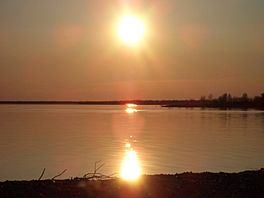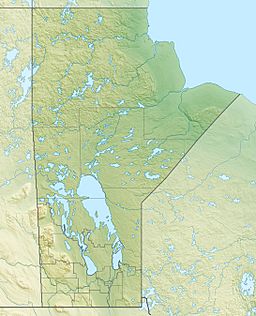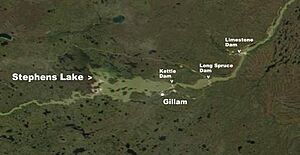Stephens Lake (Manitoba) facts for kids
Quick facts for kids Stephens Lake |
|
|---|---|

Stephens Lake from Manitoba Road 280
|
|
| Location | Division No. 23, Manitoba |
| Coordinates | 56°25′58″N 95°7′1″W / 56.43278°N 95.11694°W |
| Primary inflows | Nelson River |
| Primary outflows | Nelson River |
| Basin countries | Canada |
| Max. length | 32 km (20 mi) |
Stephens Lake is a special kind of lake called a reservoir. It's located in the province of Manitoba in Canada, north of a much bigger lake called Lake Winnipeg. This lake wasn't always here naturally. It was made in 1971 when a big wall, called the Kettle Dam, was built. The lake got its official name, Stephens Lake, in 1972.
Stephens Lake is about 32 kilometers (20 miles) long. It stretches from where the Nelson River flows into it, all the way to the Kettle Dam where the water flows out again. You can find this lake about 45 kilometers (28 miles) northeast of Split Lake. It's also about 150 kilometers (93 miles) west of the Hudson Bay, which is a very large body of saltwater.
About Stephens Lake
Stephens Lake is an important part of the Nelson River system. The Nelson River is a major river in Canada. This lake helps control the flow of water for several power plants that make electricity.
How the Lake Was Made
Stephens Lake was created by building the Kettle Dam. When a dam is built across a river, it holds back the water, forming a large artificial lake or reservoir. This is often done to store water for drinking, irrigation, or to generate electricity.
Power Plants and Nearby Towns
Downstream from Stephens Lake, along the Nelson River, there are several large power plants. These include the Kettle Generating Station, the Long Spruce Generating Station, and the Limestone Generating Station. These stations use the power of the flowing water to create electricity for homes and businesses.
The town of Gillam is located right on the southeastern shore of Stephens Lake. You can get to both the lake and the town by driving on Manitoba Provincial Road 280. This road helps people visit the area and connects the community.



